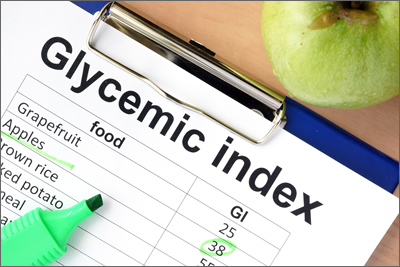Why Choose Low GI?

In reality, the Glycemic Index (GI) concept is not all that easy to grasp but it is one worth understanding, since it relates to the overall quality of the diet and also has implications for weight management.
The Glycemic Index looks at the effects of carbohydrate-containing foods on the sugar levels in your bloodstream. Whenever you eat and digest carbohydrate-rich foods - like fruits, vegetables, grains and sweets - the end result is a rise in your blood sugar. This sugar in your blood is important. It’s the primary fuel for your brain and muscles, and in large part keeps you going mentally and physically throughout your day.
Not all carbohydrate-containing foods cause your blood sugar to rise to the same degree, and this is where the Glycemic Index (or GI) comes in. The GI ranks foods according to how much and how rapidly they cause the blood sugar to rise after they’re eaten.
Which foods have the highest Glycemic Index?
The highest GI foods are those that are low in fibre but starchy or sugary - such as white bread, sweet breakfast cereals, noodles, fruit juices and white rice. Since they are digested and absorbed relatively quickly, these high Glycemic Index foods tend to cause fairly large and rapid rises in blood sugar.
Now, this burst of sugary energy might sound like a good thing. After all, we need sugar in the blood to fuel our activities but not in such large surges. That’s because a quick spike in your blood sugar is often followed by a steep drop. And suddenly you’re craving something sugary to boost your blood sugar levels back up. Then the cycle starts all over again. If you wind up snacking on sugary foods all day long, there’s a good chance you’ll take in more calories than you need, which will be put into storage on your belly and thighs.
Which foods have a low Glycemic Index?
On the other hand, the lowest GI foods are those foods that are whole and unprocessed. So, certain vegetables and whole fruits, beans, and most 100% whole grain foods - like brown rice, rolled oats, barley, quinoa and 100% whole grain bread - have relatively low Glycemic Index rankings. That’s because they’re high in fibre, which means they take longer to digest so your blood sugar rises more gently after you eat them.
Rather than a big spike in blood sugar, these foods lead to a slower release into your bloodstream, which provides you with more sustained energy. Thanks to their high-fibre content, they’re also more filling. So, a diet that emphasizes low GI foods can be a good strategy for weight control.
Herbalife Formula 1 Shake Mix has an extremely low GI of between 15-22 (depending on which flavour you choose).
Not all fruit & vegetables are created equal
When it comes to fruit and vegetables, there is a large divergence in the GI value. For example, potatoes are very high in GI regardless of whether they are fried, baked or boiled. Most root vegetables should be avoided if you are trying to lose weight. Pumpkin is also quite high at 75 (anything above 50 is relatively high). Healthy vegetables include most salad vegetables, broccoli, cauliflower, zucchini, brussel sprouts, avocados (extremely low GI), spinach and cabbage. When it comes to fruit, very sweet fruits like watermelon and bananas - especially very ripe bananas - are high GI whereas apples, berries and figs are low GI.
Adjusting the Glycemic Index of your diet
To cut back on your high GI foods and reduce the carbohydrate load of your diet overall, here are some switches you can easily make.
Instead of white rice switch to brown rice - or even better, brown basmati rice - which has a GI of only 45. Wild rice is also very good but is a lot more expensive.
Instead of white bread, choose wholemeal or whole grain bread. Toasting your bread also decreases the GI.
The message here is try to avoid anything made with highly processed carbohydrates, like plain white flour. And I probably don't need to mention sugar here. It is one of the worst offenders. Try to substitute a natural sweetener like stevia, but avoid artificial sweeteners which contain Aspartame and similiar chemicals.
Whole and lightly processed low GI foods are more bulky and filling than their refined cousins, which means they retain their natural vitamins, minerals and healthy antioxidant phytonutrients, too. That means that you get more nutrition for your calories. By swapping out the high GI foods and replacing with more low GI items, you can greatly reduce the overall carbohydrate load of your diet - which can help you with calorie control while providing a healthy nutrient boost
Based on an article by Susan Bowerman - Herbalife Director, Worldwide Nutrition, Education & Training.

